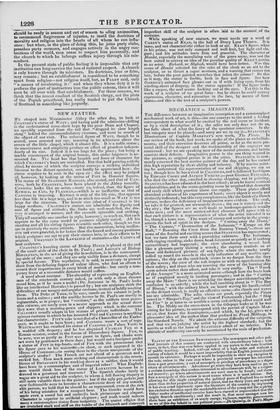MECHANICS v. IMAGINATION.
THE difference between an imaginative conception and a commonplace mechanical work of art, is this—the one conveys to the mind a feeling correspondent to what would be excited by the real scene or incident, or by a vivid description of it ; the other not only does not do so, but falls short of what the fancy of the spectator conceives. In the last category must be placed—and sorry are we to say it— STA ELIA Illustrations of Captain Illamtvax's new work, The Pirate. In our review of the book, last week, we spoke of the plates as embellish- ments; and their execution deserves all praise, as far as the mere pic- torial skill of the designer and the workmanship of the engraver are concerned : but we are speaking now of the mental process, and herein consists their defects. Imaginative power is the one thing wanted in the pictures, as original genius is in the artist. STANFIELD is com- monly esteemed the best marine painter of the day, and he has earned this high reputation by sheer ability and industry. If by marine paint- ing be understood the representation of sea and shipping, we say so too ; though here he has a rival in CHAMBERS, and is followed hard upon by EDWARD COOKE and ALFRED VICKERS ;—poor GEORGE REINAGLE, who died the other day, excelled in drawing shipping, not in painting. STANFIELD has been educated in the best school ; at sea he learnt nautical technicalities, and in the scene-painting room he acquired that dexterity and ready skill which practice alone can supply. These plates afford abundant evidence of his expertness of hand; every object is neatly and distinctly indicated ; but this very completeness, like the finish of a Dutch picture, makes the deficiency of imagination more evident. The craft, we take, it for granted, are accurately drawn ; the sea is watery and the sky airy ; the figures are as well made as landscape-painters usually make men ; and the most matter-of-fact observer will agree with us that each picture is a representation of what the artist intended it to be, though a tame one. The want of energy and activity in the groups attests the lack of spirit in the designs. " Cutting away the Masts," " The Capture," " Destruction of the Indianian," " Escape on the Raft," " Rescuing the Crew from the Burning Vessel,"—these are some of the fearful and exciting scenes that STANFIELD has represented ; but we turn them over with a provoking calmness. The Indiaman, with rigging standing, sinks down head-foremost as quietly as if nothing extraordinary bad happened ; the crew abandoning a vessel look like a pleasure-party visiting a wreck ; the capture reminds us of those old-fashioned pictures of sea- fights where the smoke neatly rolled' up round the vessels is the only indication of any warlike ope- rations; the ship on the sand-bank seems in no danger from the fury of the waves; the crew of the raft inspire us with no apprehension for their safety ; and those who are rescuing the crew of the burning ship seem ashore rather than afloat, and take it very coolly. The " Wreck of the Avenger" is a more animated scene —though here the boats look as if employed merely in landing passengers ; and in the " Cutting away the Masts " there is no mistaking the danger notwithstanding the confusion is so orderly ; while the hull tumbling about in " The Bay of Biscay," with the solitary black on board waving his handkerchief to the distant vessel, is really an effective scene—the clouds and waves too are admirable. The calm views are good, especially the Pirate vessel in " Sleeper's Bay," and the view of Portsmouth ; but the " Ship on Fire " is as tame as so terrible a scene and striking effect could well be. The Middy on the cross-trees in the titlepage looks as if he was sitting for his picture, to correspond with the portait of Captain MAR- RYAT, that forms the frontispiece,—and which, by the by, gives usa pleasanter idea of the author than that prefixed to Frank .Mildniag, in the Standard Novels. We admit the extreme difficulty of the subjects, and that we are judging the artist by the highest standard; but the merits as well as the fame of STANFIELD admit of no inferior. The altitude of mediocrity can only be ascertained by the scale of perfection.


























 Previous page
Previous page